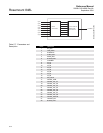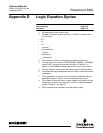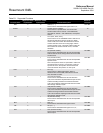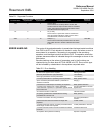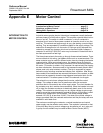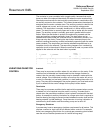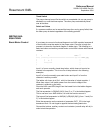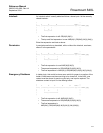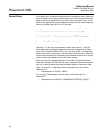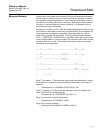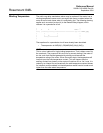
Reference Manual
00809-0100-4696, Rev AA
September 2004
Rosemount 848L
www.rosemount.com
Appendix E Motor Control
Introduction to Motor Control . . . . . . . . . . . . . . . . . . . . . . page E-1
Variations on Motor Control . . . . . . . . . . . . . . . . . . . . . . . page E-2
Writing 848L Equations . . . . . . . . . . . . . . . . . . . . . . . . . . . page E-4
INTRODUCTION TO
MOTOR CONTROL
Industrial motors require about a kilowatt per horsepower, usually delivered
as three phase AC at 440 volts or higher. This requires a special switch to turn
them on and off. The switch is called a contactor, in which a solenoid is
energized to pull a set of three power contacts to close the circuit to turn the
motor on. The contacts are large enough to carry the starting current without
welding. They are separated by insulation suitable for the supply voltage. The
solenoid is de-energized to turn the motor off. Springs quickly separate the
contacts to prevent arc damage, which can be severe at higher voltages. A
contactor for a 400 HP 2500 VAC motor may be housed in a steel box that is
two feet square and five feet high.
The three phase wires to the motor go through three overload heaters. There
are no contacts in this wiring, just heaters that mount on screw terminals. The
same contactor may be used for different motor sizes by changing the heater
overload rating. When an overload occurs, the heaters cause a contact to
open that is in series with the contactor’s solenoid, which removes power from
the motor. (This action is called a “trip” because it is mechanically like tripping
an alarm mechanism. Alarms are said to trip because the early electric bank
alarms used a trip wire to detect a robber.) The trip is supposed to happen
before the motor windings overheat and destroy their insulation. After things
have cooled off and someone has removed the cause of the overload, a reset
button must be pressed to close the heat triggered mechanical latch for the
overload contact. This allows power to flow in the solenoid circuit again.
The solenoid runs at a lower voltage than the motor, called the control
voltage. This voltage is taken from a transformer within the contactor
enclosure that is connected to two of the supply wires. The circuit breaker for
the contactor may be in another box somewhere. When the breaker is turned
off (or trips) the contactor enclosure is electrically dead, even for the control
voltage. The contactor’s solenoid may run at a higher voltage to get enough
power to move the contact assembly against its springs. A pilot relay is used
to switch that voltage within the enclosure. The control voltage seldom
exceeds 120 VAC or is less than 24 VAC. One side of the control voltage is
always grounded. Both the overload mechanism and the pilot relays are now
available in solid state form.
The enclosure containing the contactor, overload mechanism and control
power supply may be called a motor starter. The contactor’s solenoid or that
of the pilot relay carrying control voltage may be called a coil, as in relay coil.
A group of motor starters may be called a Motor Control Center (MCC).




